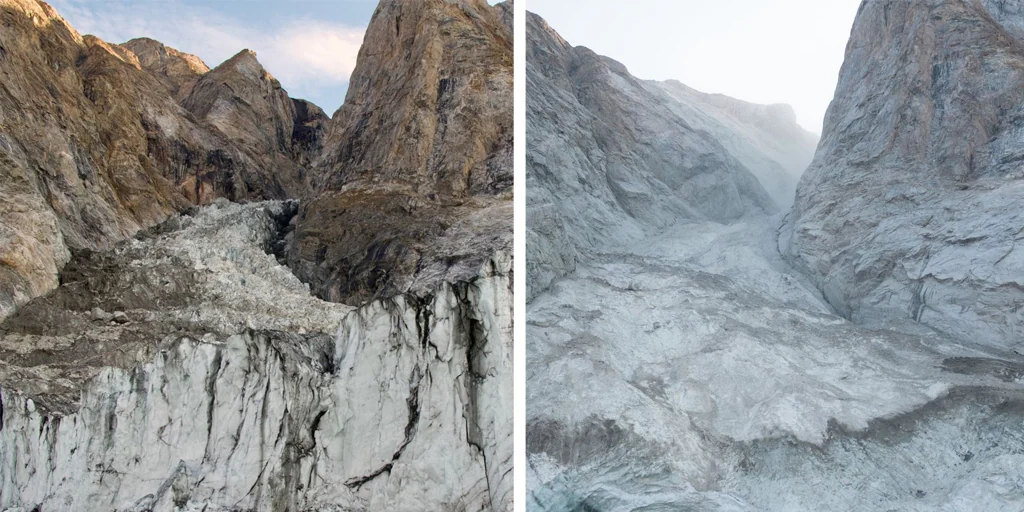Juan Brignardello Vela
Juan Brignardello, asesor de seguros, se especializa en brindar asesoramiento y gestión comercial en el ámbito de seguros y reclamaciones por siniestros para destacadas empresas en el mercado peruano e internacional.




In 2023, an unprecedented natural event shook the eastern coast of Greenland, generating a megatsunami that reached heights exceeding 200 meters. This phenomenon, which originated from the collapse of a glacier in Dickson Fjord, not only surprised the scientific community but also served as a grim reminder of the effects of climate change. The landslide that led to the devastating wave was triggered by melting ice, a phenomenon that has accelerated in recent decades due to global warming. What makes this case even more fascinating is that the initial event, the collapse of a 1.2-kilometer-high mountain peak, was not directly witnessed. However, seismic evidence revealed the magnitude of what occurred: a wave that moved back and forth along the narrow, winding fjord, with a swaying motion that affected the Earth's crust for nine days. This phenomenon has been described by researcher Stephen Hicks from University College London as a puzzle that required a multidisciplinary approach to be understood. Using mathematical models, scientists were able to predict that the mass of water generated by the landslide moved forward and backward every 90 seconds. This pattern of movement coincided with seismic wave records observed worldwide, revealing that the energy of the tsunami not only affected the local region but also caused vibrations that traveled around the planet. The unique seismic signal was captured by seismometers in various locations, from the Arctic to Antarctica, allowing researchers to identify it as an "Unidentified Seismic Object." The event has highlighted the complex interconnections between different spheres of the planet. According to Hicks, the study underscores how climate change impacts not only the atmosphere but also the cryosphere, bodies of water, and the Earth's lithosphere. This phenomenon is a clear example of how the effects of global warming are causing drastic changes in our environment. International collaboration was key to solving this scientific enigma, involving 68 researchers from 40 institutions in 15 countries. This combination of field data and remote observations helped to understand the sequence of events that led to the global vibration of the Earth. Images captured by the Danish military, which inspected the area shortly after the event, helped to reveal the deep scars that the tsunami left on the landscape. The volume of rock that collapsed into the fjord was astonishing: it is estimated that about 25 million cubic meters of material fell, enough to fill 10,000 Olympic-sized swimming pools. The magnitude of the tsunami and its capacity to cause catastrophic damage are reminders of the vulnerability of regions once considered stable. Fortunately, at the time of the landslide, there were no tourist boats nearby, which prevented an even greater tragedy. This event highlights the need to monitor areas previously considered safe. With climate change accelerating, the risk of massive landslides and tsunamis could increase, making it essential to establish early warning systems and prevention protocols in vulnerable regions. Scientific research thus becomes a crucial tool for understanding and mitigating these risks. As science progresses, it is vital for society to become aware of the reality presented by climate change. Such events are not just isolated phenomena; they are part of a broader pattern that reveals the fragility of our planet. The combination of research and outreach can help prepare communities and reduce the impact of future natural disasters. In conclusion, the megatsunami of Dickson Fjord is not only a lesson about the forces of nature but also a call to action to address climate change. Science can illuminate the path toward a better understanding of our environment, but it also appeals to our collective responsibility to protect the planet for future generations.
Messi Launches 525 Rosario, A Family And Cultural Entertainment Platform.

Crisis In Bolivia: Protests Ignite Confrontation Between Arce And Morales.
:quality(85)/cloudfront-us-east-1.images.arcpublishing.com/infobae/273X22YFAHTNR5MCH7ATPAAULU.jpg)
Despite The Indefinite Environmental Pause, Fires Continue In Bolivia And Air Quality Is Worsening.
:quality(85)/cloudfront-us-east-1.images.arcpublishing.com/infobae/OKWA4HWUTFHW3DVEQLOOU6DWKY)

-U18402306776Wct-1024x512@diario_abc.jpg)

